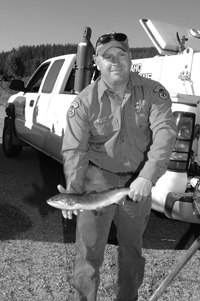Though the number of sockeye salmon arriving in the Sawtooth Valley appears to be slowing, enough have showed up to push the year's run past the 500 mark, a remarkable development for a fish some had written off in recent years.
A total of 507 sockeye had arrived at fish traps near the Sawtooth Fish Hatchery near Redfish Lake by Monday morning, information provided by the Idaho Department of Fish and Game indicates. That's nearly double the next highest run in recent decades, when 257 of the famous red fish made their way back to the Sawtooth Valley in 2000.
In the past few days, the number of sockeye arriving daily has dropped to less than 20, with a low of just nine on Monday. That's down from a high of 42 sockeye that arrived on Aug. 19.
In recent years, sockeye returns have varied widely in the upper Salmon River. Anadromous fish must cross eight major dams on the Columbia River and lower Snake River before they reach Idaho.
Though this summer's run is indeed a remarkable improvement above mostly dismal single-digit or nonexistent sockeye returns to Redfish Lake during the past several decades, the Sawtooth Valley sockeye population is far from recovered, fisheries officials have said. In the mid-1950s, thousands of the fish returned to spawn in Redfish, Pettit, Alturas and other lakes located in the shadow of the Sawtooth Mountains.
This year's positive sockeye returns have been attributed to good smolt production four years ago, good out-migration conditions in the rivers and excellent ocean conditions.
Redfish Lake sockeye salmon (Oncorhynchus nerka) were listed as endangered under the federal Endangered Species Act in 1991. They were the first Idaho salmon to be listed under the ESA. Redfish Lake sockeye are unique in that they travel to the highest elevation, over 6,500 feet, run the longest distance, about 900 miles, and travel the farthest south of any North American sockeye population.
This year's returns are the result of 180,000 smolts that were released and migrated to the ocean in 2006.


 Eagle Fish Hatchery assistant manager Travis Brown, holds a Sockeye salmon that was slated for transport to the Eagle hatchery.
Photo by Willy Cook
Eagle Fish Hatchery assistant manager Travis Brown, holds a Sockeye salmon that was slated for transport to the Eagle hatchery.
Photo by Willy Cook



































